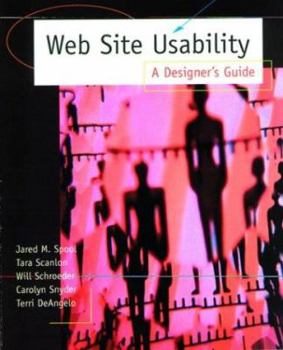Web Site Usability: A Designer's Guide
Web Site Usability: A Designer's Guide is a report that every person involved in Web design, commerce, or online marketing will want to have. This book is, undoubtedly, the most comprehensive data... This description may be from another edition of this product.
Format:Paperback
Language:English
ISBN:155860569X
ISBN13:9781558605695
Release Date:December 1998
Publisher:Morgan Kaufmann Publishers
Length:176 Pages
Weight:0.78 lbs.
Dimensions:0.5" x 7.0" x 8.9"
Customer Reviews
5 ratings
MAGNIFICENT BOOK!!!
Published by Thriftbooks.com User , 20 years ago
This book is a definite MUST HAVE for any website designer, newbie to web design and anyone and everyone who has an online business. Simple, easy to understand visuals compliment the text, which is written in a very simplistic manner. This book is wonderful - magnificent - excellent, and will help you greatly understand the elements of successful web design. I've used it to consistently update my own website, at:http://www.aei.dli.comIf you don't have this book, you're missing out on your single-most-important investment in your professional life!
Primary reference for web usability
Published by Thriftbooks.com User , 23 years ago
There are several primary sources to study Web usability. Jared Spool of User Interface Engineering is one of them. Among technical communicators, "Web Site Usability : A Designer's Guide" is mentioned often in the same sentence with Jakob Neilsen and his work. From the standpoint of communicating information, everything Jared and his team has put together has been validated over and over in my experience designing sites with very technical content. Spool (et al) takes into account all the idiosyncrasies human beings bring to their Web searches, whether for information or entertainment, and makes consistently valuable comments about users and how they behave when using the Web. This book is a jumping-off point for Web developers and not intended to be a sole reference. However, Spool remains one of the most important people in Web usability and development today.
An excellent foundation book in producing workable web sites
Published by Thriftbooks.com User , 24 years ago
The value of this book is that it makes a strong case for thinking in navigation terms when constructing web sites. The content is about how people succeed or fail, when they try to find information , on web pages. It uses real web sites as examples and explains how users rated them. The section on how to regard images and animation is crucial information for beginners to web design. The authors' scientific approach to evidence is honest. If they feel that interpretation is uncertain they say so. Overall, the book contains solid workable solutions for building effective and sensible web pages. I would recommend this book to anybody who is thinking of putting up a web site and is not sure of what approach to take.
Designers will hate this book.
Published by Thriftbooks.com User , 24 years ago
As a long-time web developer and interface designer, I liked this book a lot. It challenges a lot of the assumptions (dogma?) of the web "design" community by taking the approach that end-users are the ones who have the most to tell us about good and bad design, not creative directors.I had a recent experience with a designer who was invited to observe a focus group of prospective users of a large commercial real estate she had designed. She declined the invitation to attend with the following statement: "I have no need to know what people think of the design. I designed it with a specific purpose in mind, and I believe I achieved my goal. What could I learn?" What arrogance! Well, guess what folks? The users testing the site found it confusing, hard to navigate, difficult to search, and therefore not something they'd be likely to use. I guess if her purpose was to drive people to better sites, she succeeded.I've used techniques similar to the ones described in this book to test sites I've designed. They work! It's not always fun to hear users tell you what you've created is clumsy, confusing or downright stupid, but if you don't listen to your users and design for them, you are doomed! Don't be like the designer I mentioned above, read this book and learn something. Your sites will be better, and your users will thank you for it.
Excellent debunking of common web UI design myths
Published by Thriftbooks.com User , 25 years ago
One of my challenges in dealing with clients is convincing them that design solutions for one medium rarely apply to another. Imagine trying to make a bicycle frame out of wood using the same design you'd use for steel. It's quite possible to have a wooden frame, but they look *nothing* like the steel frame."Web Site Usability" is excellent source of material for me when I'm trying to explain and/or justify differences in design approaches based on functional requirements. This book, which makes no pretense of being a comprehensive, academic review of theoretical methods instead presents a broad variety of *real world* attempts to solve web UI problems and then describes both the strong and weak points discovered. It is, if you will, a narrative approach to understanding the issues involved in usability design, and to a lesser extent, user interface design.This narrative approach has proved far more helpful in dealing with the increasing numbers of non-technical folks who're being given the problem of creating interesting, usable, *and* attractive web sites than the typical academic approaches couched in jargon and steeped in rigid methodology. Regardless of your degree of technical knowledge, reading this book will help you in establish a strong foundation for understanding usability in all its contexts.





